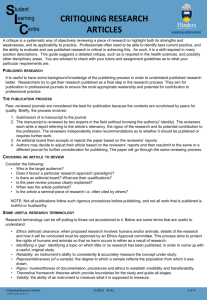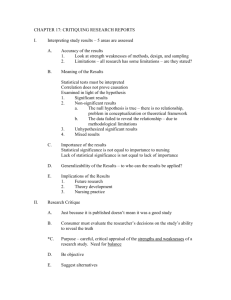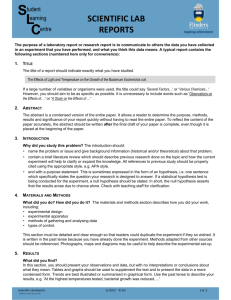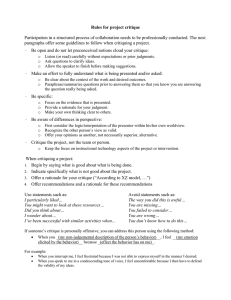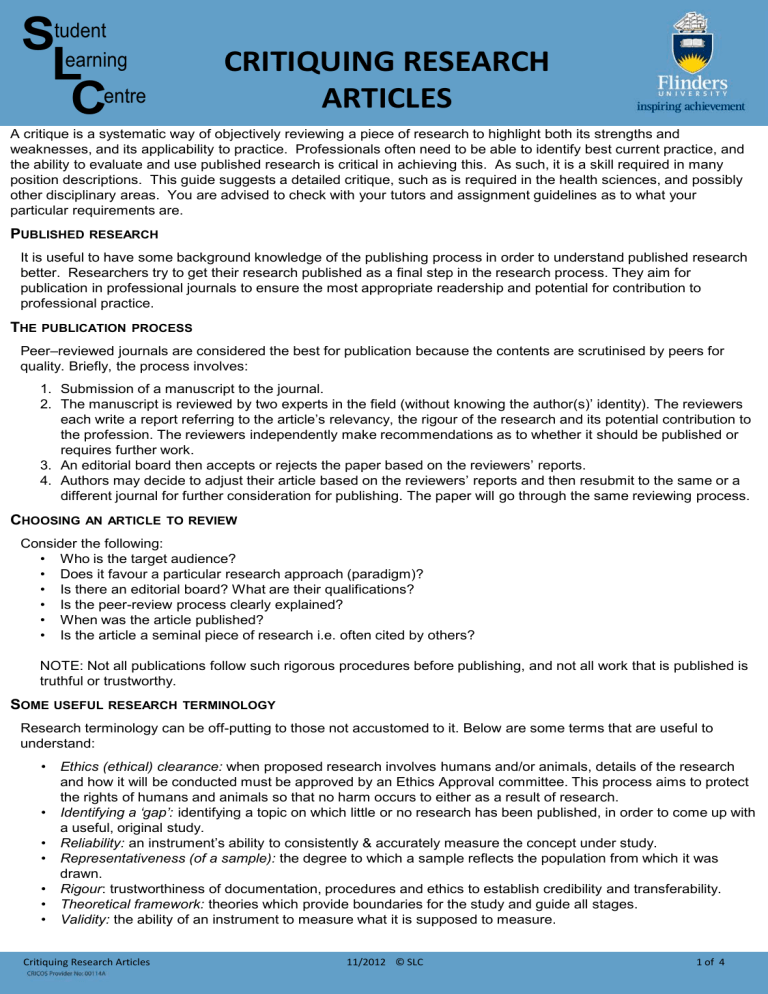
Student Learning Centre CRITIQUING RESEARCH ARTICLES A critique is a systematic way of objectively reviewing a piece of research to highlight both its strengths and weaknesses, and its applicability to practice. Professionals often need to be able to identify best current practice, and the ability to evaluate and use published research is critical in achieving this. As such, it is a skill required in many position descriptions. This guide suggests a detailed critique, such as is required in the health sciences, and possibly other disciplinary areas. You are advised to check with your tutors and assignment guidelines as to what your particular requirements are. PUBLISHED RESEARCH It is useful to have some background knowledge of the publishing process in order to understand published research better. Researchers try to get their research published as a final step in the research process. They aim for publication in professional journals to ensure the most appropriate readership and potential for contribution to professional practice. THE PUBLICATION PROCESS Peer–reviewed journals are considered the best for publication because the contents are scrutinised by peers for quality. Briefly, the process involves: 1. Submission of a manuscript to the journal. 2. The manuscript is reviewed by two experts in the field (without knowing the author(s)’ identity). The reviewers each write a report referring to the article’s relevancy, the rigour of the research and its potential contribution to the profession. The reviewers independently make recommendations as to whether it should be published or requires further work. 3. An editorial board then accepts or rejects the paper based on the reviewers’ reports. 4. Authors may decide to adjust their article based on the reviewers’ reports and then resubmit to the same or a different journal for further consideration for publishing. The paper will go through the same reviewing process. CHOOSING AN ARTICLE TO REVIEW Consider the following: • Who is the target audience? • Does it favour a particular research approach (paradigm)? • Is there an editorial board? What are their qualifications? • Is the peer-review process clearly explained? • When was the article published? • Is the article a seminal piece of research i.e. often cited by others? NOTE: Not all publications follow such rigorous procedures before publishing, and not all work that is published is truthful or trustworthy. SOME USEFUL RESEARCH TERMINOLOGY Research terminology can be off-putting to those not accustomed to it. Below are some terms that are useful to understand: • • • • • • • Ethics (ethical) clearance: when proposed research involves humans and/or animals, details of the research and how it will be conducted must be approved by an Ethics Approval committee. This process aims to protect the rights of humans and animals so that no harm occurs to either as a result of research. Identifying a ‘gap’: identifying a topic on which little or no research has been published, in order to come up with a useful, original study. Reliability: an instrument’s ability to consistently & accurately measure the concept under study. Representativeness (of a sample): the degree to which a sample reflects the population from which it was drawn. Rigour: trustworthiness of documentation, procedures and ethics to establish credibility and transferability. Theoretical framework: theories which provide boundaries for the study and guide all stages. Validity: the ability of an instrument to measure what it is supposed to measure. Critiquing Research Articles 11/2012 © SLC 1 of 4 WRITING THE CRITIQUE Critical reviews for research are systematic. They begin at the title, and review each section until the reference list at the end. It is useful to ask yourself questions about the purpose of each component of the article, and whether it achieves that purpose. THE TITLE Does the title clearly indicate what the research is about, without being extremely long or too short to be informative? Are the variables or theoretical issues stated and any relationships between them? THE AUTHOR(S) What are the author(s)’ professional and academic qualifications? Have they published previously on a similar topic? KEYWORDS Some journals require keywords to help to identify main areas of focus. Are these informative and relevant? THE ABSTRACT The purpose of an abstract is to provide a succinct summary of the contents of the article and is usually 50-250 words in length, depending on journal requirements. It should contain enough information to enable a reader to decide whether the article is of interest to them or not, so must be informative. Ask yourself: • Does it explain the purpose of the paper? • Does it explain why the research was carried out? • What was accomplished? • What were the main findings? • What is the significance of the research? • What conclusions were reached? THE INTRODUCTION The introduction should orientate the reader to the study, by: • giving a firm sense of what was done in the study • introducing the question /problem • developing the background of the study • stating the purpose & rationale of the research. Ask yourself: • Is the research question/problem researchable? • Is the problem important enough to justify the research? • Is the background of the research relevant to the research question? THE LITERATURE REVIEW The literature review should give an overview of the available literature which frames or surrounds the problem being researched. It should look at the similarities and differences between the literature, as well as the strengths and limitations. It should illustrate how the current study fits into the existing framework of research or how it fills a gap in the literature. Ask yourself: • Is the literature review broad, yet focused on the issue? • Is there historical as well as contemporary material to put the area of study into a context? • Is there convincing evidence to support assertions? • Does it fairly represent opposing views? • Does the literature review use a theoretical framework? • Does it reveal gaps in the knowledge which this research will fill? Critiquing Research Articles 11/2012 © SLC 2 of 4 THE AIM: The aim must be clearly stated, focused on one main idea and should convey the main purpose of the study. Ask yourself: Do you have a clear idea of what the study tried to achieve? THE RESEARCH DESIGN: This section should clearly state what the researcher did and how it was done, allowing the reader to evaluate the methods used, the consistency, the reliability of the study, its validity and whether it could be replicated. As a minimum, there should be a brief synopsis of the research approach taken. Once the research method is established, the reader can critique the research design for methodological rigour. The method section of the research design usually has subsections which describe the participants, the materials and the procedure. The detail should be sufficient to clearly explain the research design, without excessive detail, so that no questions remain. • • • • Participants or sample: The number of participants, their characteristics and the selection process used should be described. Do the participants represent the research well? If any participants did not complete the study, this should be explained. Details such as any payments made to participants and details of major demographic information should be made evident, for example, geographical location, gender, age, affiliation with any institutions etc. Ethics clearance: The process of obtaining ethics clearance and how ethical standards were maintained should be made clear. Use of apparatus: If any apparatus were used it should be briefly identified and described, and its function in the research explained. If any apparatus were obtained or donated by a commercial source, this must be stated. Procedure: Each step in the research procedure should be explained. This includes any instructions to the participants, the formation of groups, and any experimental manipulations. Any control features in the research design should be stated. Ask yourself: • Is there a clear rationale for the chosen research approach, methods and/ or instruments used? • Is the research method appropriate for the research question? • Was the collection of data appropriate for the research question? • Is there enough information concerning the participants? • What were the ethical considerations for the research and the participants? • Were the methods and/or instruments described in enough detail? • Were any ambiguous terms used? • Is the method deemed reliable and valid? • Are any limitations of the study discussed? DATA ANALYSIS (also known as the Results and Findings section) This section should contain a summary of the data collected and the main results and findings, in enough detail so that the reader can understand how the conclusions that are drawn later in the article have been reached. In qualitative research, illustrative samples of data are frequently used. In quantitative data, individual scores or raw data are not discussed. All relevant data, including that which runs counter to the hypothesis, should be discussed. Tables and figures should be used for clear representation of data. (In the discussion section, this data should be discussed in text, not as data.) The reader should be made clear as to what the data provided means and why it is important. Critiquing Research Articles 11/2012 © SLC 3 of 4 Ask yourself: • Were the steps involved in the data analysis explained and the strategies justified? • Was the data analysis rigorous enough to substantiate the claims? • Were all data taken into account? If not, why not? • Are the presented results relevant to the research question? • Do the tables and graphs (if any) make the data analysis clearer? THE DISCUSSION In this section, the implications of the research results are evaluated and interpreted in relation to the research question. This is where the findings and the selected theoretical framework come together. The discussion should contain a clear statement of support or otherwise of the original hypothesis or research question. The results of this study and those of other studies should be discussed, and any suggestions for improvements or further research are made here. There should be no repetition of points already made in other sections. Ask yourself: • Have the results been interpreted in relation to the research question and aims? • Have the results been discussed with reference to the research question, hypothesis (if applicable) and theoretical or conceptual frameworks? • Have conclusions and /or recommendations been appropriately drawn from the data analysis? • Did the researcher highlight the most important results? • Have the results been used to support or refute the results of other studies? • How relevant and useful are the results to practice? CONCLUSION This section should summarise the main points, and indicate the usefulness of the research. It should not include any new information. Areas for future research may be suggested. Ask yourself: • Were the main points drawn out? • Were fresh insights or a new perspective on the topic demonstrated? • Have any recommendations been made based on the research? • Were there any suggestions for future research? REFERENCE LIST OR BIBLIOGRAPHY This should contain a list of all sources referred to in the article (in the case of a reference list) or all sources actually accessed in preparation for the article (in the case of a bibliography). Ask yourself: • Are all sources cited clearly and with full bibliographic details provided? • Has a wide range of works in the field been referred to? • Does the list contain both seminal (classic) and more contemporary literature? REFERENCES: Ryan, F, Coughlan, M & Cronin, P 2007, ‘Step-by-step guide to critiquing research. Part 2: qualitative research’, British Journal of Nursing,, vol. 16, no. 12, pp. 738-743. Stockhausen L & Conrick, M 2002, ‘Making sense of research: a guide for critiquing a paper’, Contemporary Nurse, vol. 14, no. 1, pp. 38-45. . STUDENT LEARNING CENTRE REGISTRY BUILDING ANNEXE TEL: 61-8-8201 2518 E-MAIL: slc@flinders.edu.au INTERNET: http://www.flinders.edu.au/SLC POSTAL: PO BOX 2100, ADELAIDE, SA 5001 Critiquing Research Articles 11/2012 © SLC 4 of 4
